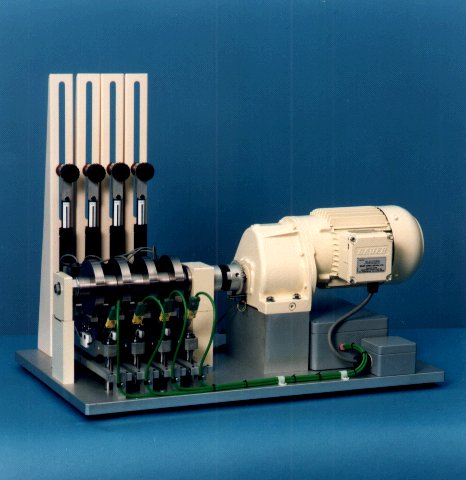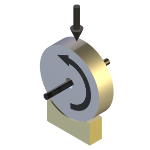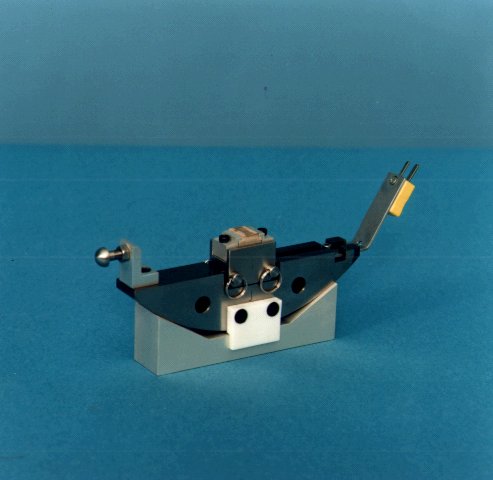-


Description
The Multi-Station Block-on-Ring Machine is a cost effective wear and friction test machine with simple test specimens offering conforming and non-conforming block-on-ring contact geometry. It has a series of four friction and wear test stations independently loaded but on a common rotating shaft. The machine meets and exceeds the requirements of ASTM G 137-95. Relocating block specimen holders provide for accurate re-positioning of the specimens after weighing: this enables wear to be measured during long period tests. The control unit includes a Serial Link Interface Module and Windows based software for control and data acquisition.
The block specimen is mounted in a small holder which in turn is located and pinned to a carriage. This arrangement ensures that the mass of the holder + block specimen is minimised and that accurate relocation is possible. The holder + block specimen may be removed periodically during a test, weighed and then re-inserted accurately in the machine.
The carriage is supported on roller bearings, these in turn form part of the loading assembly. The carriage is prevented from rotating on its arc by a strain gauge load cell. This senses the friction force (or torque in the case of conforming specimens) transmitted between the block and the test ring.
Two block specimen clamp sets are provided, one for ASTM 6.0mm x 6.35mm specimen size (these can be conveniently cut from unnotched IZOD test bars) and one for 10mm x 14mm x 4mm thick specimen cut from a standard tensile test strip. In the latter case, in order to clamp the block, the test specimen must be cut larger in one dimension with steps for clamping.
The loading carriage assembly is constrained to move in a vertical direction by two linear bearing guides. Upward force on the loading assembly (and hence on the specimen carriage and block specimen) is provided by means of a pivoted load arm. To remove specimens during a test for weighing simply requires the lowering of the load arm and removal of the carriage.
The upward force on the load arm is provided by means of a spring balance on a vertical bracket. The mechanical advantage of the load arm is 2:1. Very light loads may be applied since the weight of the carriage is counteracted by the spring balance.
The specimen carrier and loading assembly are designed to de-couple load and friction force measurement. The use of the spring balance for loading is to minimise the inertial effects which can be considerable with dead weight loaded systems.
Each of the four test stations are separately instrumented with a friction force sensing transducer. Four test rings are clamped onto a lay shaft, driven by the variable speed geared ac motor: four tests are carried out simultaneously.
Temperature in the block specimen is monitored by a thermocouple that may be set either to touch the rear face of the block or to be embedded in the block, thus indicating the temperature nearer to the contact.
Control and Data Acquisition
The TE 56 has PC based sequence programmable control and data acquisition. This is provided by an integrated Serial Link Interface Module and COMPEND 2000 software running on a host PC, operating under Windows. Data is stored to hard disc in standard spread sheet compatible file formats (.csv or .tsv).
Tests are defined by a sequence of steps, each step containing set-point, data recording rates and alarm level information. Set-points may be adjusted by step change or ramp. The test sequence is followed unless interrupted by the operator or an alarm. Set-points may also be adjusted manually using on screen toggles.
-
Technical Specifications
Number of Test Stations: FOUR Contact Geometry: Conforming Block on Ring Non-conforming Block on Ring Load Range: 0 to 150 N (1 N resolution) Rotational Speed Range: 10 to 380 rpm Sliding Speed Range: 0.04 to 2 m/s Ring Specimen: 100 mm diameter x 16 mm wide Block Specimen: 6.35 mm x 6.00 mm x 12.7 mm 14 mm x 14 mm x 4 mm Interface: Serial Link Interface Module Software: COMPEND 2000 Motor: 0.55 kW ac Controlled Parameters Rotational Speed Test Duration Recorded Parameters Friction Force (4 stations) Load (4 stations) Rotational Speed Friction Coefficient (4 stations) Services Electricity: 220/240 V, single phase, 50 Hz, 1.2 kW 110/120 V, single phase, 60 Hz, 1.2 kW Installation Bench-mounting machine: 720 mm x 440 mm x 570 mm high, 80 kg Bench-mounting cabinet: 530 mm x 420 mm x 300 mm high, 30 kg Packing Specification: 1.73 m3, GW 338 kg, NW 240 kg -
Applications
-
Publications
Paper # 611 A Tribological Study for an Increased Coefficient of Friction in the Extraction of Sugarcane Juice G OLIVER, Tribology Transactions Volume 50, Issue 2 April 2007 , p. 198 – 204 Paper # 645 A comparison of the abrasive wear behaviour of iron-chromium based hardfaced coatings deposited by SMAW and electric arc spraying VE Buchanan, DG McCartney and PH Shipway Wear Volume 264, Issues 7-8, 15 March 2008, p. 542-549 -
User List
Launched 1997
University of Technology Jamaica LNP Plastics Engineering Europe B.V. Netherlands -
Download the Machine Leaflet

